Precision Stamping Parts are critical to the choice of material, as it directly affects the accuracy, performance, and cost of the product. Here are some of the materials commonly used for precision stampings:
Stainless steel: Stainless steel has become a common material for precision stamping parts due to its excellent corrosion resistance and high strength. Especially in applications that require long-term accuracy and stability, such as medical devices and electronic components, stainless steel is favored for its excellent formability and mechanical properties.
Carbon steel: Carbon steel is widely used in various precision stamping parts because of its high strength and good machinability. By adjusting the carbon content and heat treatment process, different levels of hardness and toughness can be obtained to meet the needs of different applications.
Aluminum alloys: Due to their light weight, high strength, and good formability, aluminum alloys excel in applications where weight reduction is required while maintaining high accuracy. In aerospace, automobile manufacturing and other fields, aluminum alloy precision stamping parts are particularly widely used.
Copper and copper alloys: such as brass, phosphor bronze, etc., have good electrical conductivity, thermal conductivity and formability, and are suitable for precision stamping parts in electrical, electronic and other fields. These materials offer significant advantages in the manufacture of precision connectors, terminals, and other components.
Special alloys: For some special application scenarios, special alloys may be required to manufacture precision stamping parts. These alloys typically have excellent properties such as high temperature resistance, corrosion resistance, or high strength to meet specific working environment requirements.
When choosing the material of precision stamping parts, in addition to considering the properties of the material, it is also necessary to consider the feasibility of the stamping process. Different materials may exhibit different formability, resilience and wear resistance during the stamping process, so it is necessary to select the right material according to the specific stamping process requirements.
